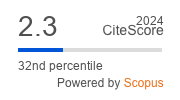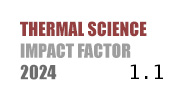THERMAL SCIENCE
International Scientific Journal
MICROWAVE HEATING AND FRACTURING CHARACTERISTICS OF BASALT INSIGHTS FROM INFRARED THERMAL IMAGING
ABSTRACT
Microwave heating is a promising assisted rock-breakage technology. However, the non-uniform temperature distribution in microwave-heated rocks has not been quantitatively studied. In this work, the microwave heating experiment with power ranging from 1.5-7.5 kW was conducted to investigate the fracturing and heating characteristics of basalt. The results show that the fracture time of basalt decreases non-linearly with increasing power, while the surface temperature increases linearly with irradiation time. For a fixed time, the uniformity of temperature distribution is more affected by power, while for a fixed input energy, the uniformity remains essentially unchanged. Increasing microwave power is more effective in enhancing the non-uniformity of temperature distribution and the increase of thermal stress.
KEYWORDS
PAPER SUBMITTED: 2024-10-04
PAPER REVISED: 2024-11-13
PAPER ACCEPTED: 2024-11-22
PUBLISHED ONLINE: 2025-06-01
THERMAL SCIENCE YEAR
2025, VOLUME
29, ISSUE
Issue 2, PAGES [1449 - 1454]
- Gao, M. Z., et al., The Mechanism of Microwave Rock Breaking and Its Potential Application Rock-Breaking Technology in Drilling, Petroleum Science, 19 (2022), 3, pp. 1110-1124
- Tang, M. Y., et al., Failure Behavior and Energy Evolution Characteristics of Deep Roadway Sandstone under Different Microwave Irradiation Modes, Journal of Central South University, 30 (2023), 1, pp. 214-226
- Gao, M. Z., et al., Fractal Evolution and Connectivity Characteristics of Mining-induced Crack Networks in Coal Masses at Different Depths, Geomechanics and Geophysics for Geo-Energy and Geo-Resources, 7 (2021), 1, ID9
- Zheng, Y. L., et al., Challenges and Opportunities of Using Tunnel Boring Machines in Mining, Tunnelling and Underground Space Technology, 57 (2016), 8, pp. 287-299
- Yang, B. G., et al., Exploration of Weakening Mechanism of Uniaxial Compressive Strength of Deep Sandstone under Microwave Irradiation, Journal of Central South University, 29 (2022), 2, pp. 611-623
- Lu, G. M., et al., Influence of Microwave Treatment on Mechanical Behaviour of Compact Basalts under Different Confining Pressures, Journal of Rock Mechanics and Geotechnical Engineering, 12 (2020), 2, pp. 213-222
- Li, J. L., et al., Fully-Coupled Simulations of Thermally-induced Cracking in Pegmatite due to Microwave Irradiation, Journal of Rock Mechanics and Geotechnical Eng., 11 (2019), 2, pp. 242-250
- Toifl, M., et al., Numerical Study of the Influence of Irradiation Parameters on the Microwave-Induced Stresses in Granite, Minerals Engineering, 103 (2017), 4, pp. 78-92
- Kahraman, S., et al., The Influence of Microwave Treatment on the Compressive and Tensile Strength of Igneous Rocks, International Journal of Rock Mechanics and Mining Sciences, 129 (2020), 5, ID104303
- Pressacco, M., et al., Numerical Modelling of Microwave Heating Assisted Rock Fracture, Rock Mechanics and Rock Engineering, 55 (2022), 2, pp. 481-503
- Zhao, Q. H., et al., Microwave Fracturing of Water-bearing Sandstones: Heating Characteristics and Bursting, International Journal of Rock Mechanics and Mining Sciences, 136 (2020), 12, ID104495
- Hassani, F., et al., The Influence of Microwave Irradiation on Rocks for Microwave-assisted Underground Excavation, Journal of Rock Mechanics and Geotechnical Engineering, 8 (2016), 1, pp. 1-15
- Pressacco, M., et al., Numerical Modelling of Microwave Irradiated Rock Fracture, Minerals Engineering, 203 (2023), 11, ID108318
- Ahmadihosseini, A., et al., Computational Study of Microwave Heating for Rock Fragmentation, Model Development and Validation, International Journal of Thermal Sciences, 181 (2022), 11, ID107746
- Sun, T. W., et al., Microwave Heating and Fracturing of Granite: Insights from Infrared Thermal Imaging, Journal of Thermal Stresses, 45 (2022), 9, pp. 762-771

